Showing all 28 results
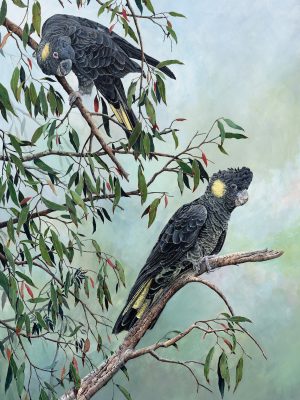
’I’m Up Here’! - Yellow tailed Black Cockatoos
Limited Edition print size: 100 cm x 80 cm. Printed on 310 gsm Museum quality art paper.
This is a signed limited edition print.
*Price includes postage anywhere within Australia.
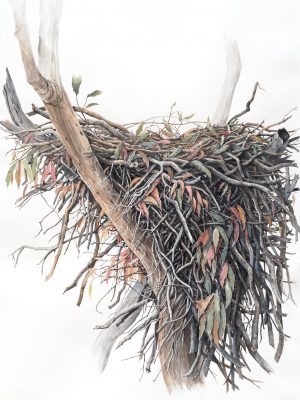
‘The Eyrie’ - Tasmanian Wedge-tailed Eagle Nest (Aquila audax fleayi)
Limited Edition print size: 100 cm x 80 cm. Printed on 310 gsm Museum quality art paper.
Wedge-tailed eagle nesting habitat is generally restricted to predominantly closed canopy old growth native forest, almost exclusively in tracts of tall eucalypt forest. Trees selected for nesting are among the largest in the locality, typically greater than 27 metres (89 ft) in height, with few exceptions. Nest trees normally occur on leeward slopes sheltered from prevailing strong winds.
The nest is a large structure of dead sticks, usually reused for years, often reaching considerable size. Nests 1.8 m across, 3 m deep and weighing about 400 kg are known. Nests have a shallow cup on the top, lined with fresh twigs and leaves. Sticks are added by a bird while it stands in the nest. If these sticks are dropped outside the nest, no effort is made to retrieve them. (With special thanks to Geoff ‘Hutcho’ Hutchinson for his fabulous reference images)
Listed: Endangered
This is a signed limited edition print.
*Price includes postage anywhere within Australia
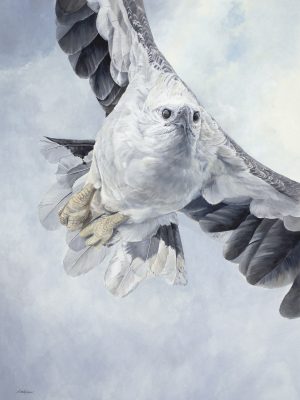
Limited edition print size 100 cm x 80 cm
Few Australian birds of prey are as spectacular as the White-bellied sea eagle (Haliaeetus leucogaster). The White-bellied sea eagle is a large raptor that has long, broad wings and a short, wedge-shaped tail. It measures approximately 80 cm in length, and has a wingspan of 180–220 cm. Females weigh between 3-4.5 kg, and are larger than the males, which weigh between 2.5-4 kg
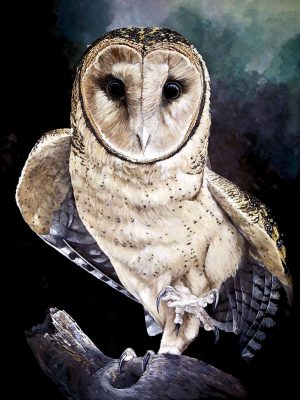
Limited edition print size 100 cm x 80 cm
The Tasmanian masked owl (Tyto novaehollandiae castanops) is a bird in the barn owl family Tytonidae that is endemic to the island state of Tasmania, Australia. It is the largest subspecies of the Australian masked owl, the largest Tyto owl in the world, and is sometimes considered a full species. The sub-specific name castanops, meaning “chestnut-faced”, comes from the colouring of the facial disc.
*Price includes postage anywhere within Australia.
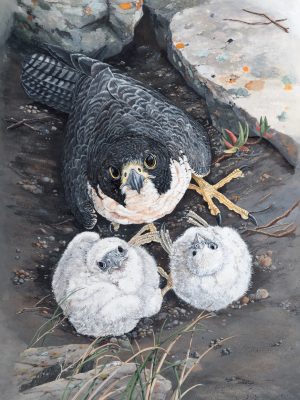
Limited Edition print size: 80 cm x 60 cm. Printed on 310 gsm Museum quality art paper.
'You're Late ' - Peregrine family (Falco peregrinus)
This female Peregrine was successfully rehabilitated at the Raptor Refuge of Tasmania, Kettering. A joy to watch and a very good news story.
The Peregrine Falcon is the embodiment of apex hunter; fastest animal in the world and master of the famous Peregrine ‘stoop’.
My portrait of Peregrine domesticity hopefully provides the viewer with a snapshot of another side to these magnificent raptors - that of protective maternal instinct and total commitment.
While the female incubates the eggs and the chicks newly hatched the family unit is fed on the nest by the male, hence her expression …’You’re Late’
(My sincere thanks to Luke O’Brien for his superb reference images)
This is a signed limited edition print.
*Price includes postage anywhere within Australia
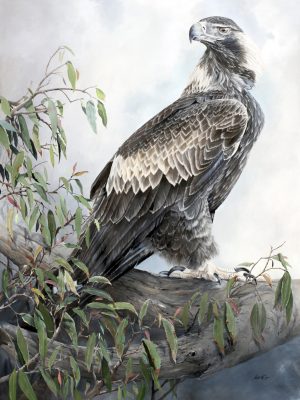
Juvenile Wedge-tailed eagle, Limited Edition Print size: 80 cm x 60 cm
The endangered Wedge-tailed Eagle subspecies Aquila audax fleayi occurs only in Tasmania. It is distinguished by its size (being Australia's largest bird of prey) and wedge-shaped tail. The total adult population has been estimated as less than 1000 birds. Principal threats include loss of nesting habitat, nest disturbance, collisions (with artificial structures, vehicles and aircraft), electrocution and persecution.
Aquila is a beloved member of The Raptor Refuge Inc. which is a not-for-profit organisation dedicated to caring and protecting Tasmania’s natural wildlife. https://www.raptorrefuge.com.au/
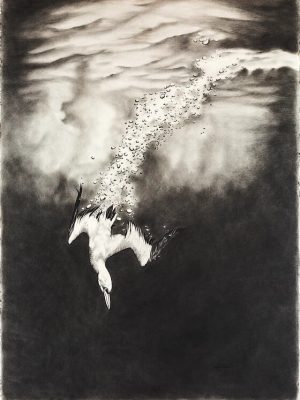
This Limited Edition Print is 60 cm x 80 cm
The Australasian gannet (Morus serrator), also known as Australian gannet and tākapu, is a large seabird of the booby and gannet family, Sulidae. Adults are mostly white, with black flight feathers at the wingtips and lining the trailing edge of the wing. These amazing birds dive from heights of 30 metres, entering the water at speeds of up to 100 km/h.
This is an Archival Print.
Price includes postage within Australia
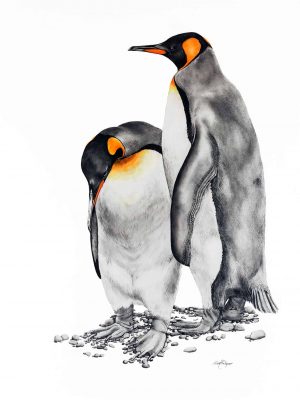
Print Size: 80cm x 60cm
The king penguin (Aptenodytes patagonicus) is the second largest species of penguin, smaller, but somewhat similar in appearance to the emperor penguin. There are two subspecies: A. p. patagonicus and A. p. halli; patagonicus is found in the South Atlantic and halli in the South Indian Ocean (at the Kerguelen Islands, Crozet Island, Prince Edward Islands and Heard Island and McDonald Islands) and at Macquarie Island.[2]
King penguins mainly eat lantern fish, squid and krill. On foraging trips king penguins repeatedly dive to over 100 meters (300 ft), and have been recorded at depths greater than 300 meters (1,000 ft).[3]
King penguins breed on the sub-antarctic islands at the northern reaches of Antarctica, South Georgia, and other temperate islands of the region.
This is an archival print. To view our limited edition prints click here.
*Price includes postage anywhere within Australia.
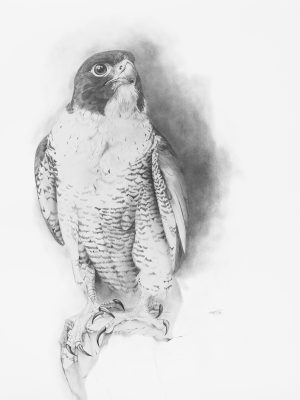
Peregrine falcon (Falco peregrinus)
All confirmed nests in Tasmania have been on cliffs. A site sheltered from heavy rain or high chill-factors is preferred and just a scrape is made to lay eggs.
Tasmania is a great place for peregrines but far from the best. The nesting population recovered from ravages of organochlorine pesticides in the 1960s, 1970s and into the 1980s, through legal protection in the early 1970s to now. With approximately 120 breeding pairs, the population has been relatively stable for some years now. Most are clustered in river valleys and along suitable coastline and on inshore islands and where close (< 4km apart) pairs tend to be evenly distributed due to their territorial nature. Nests are fiercely defended against all kinds of perceived threats and predators.
Size: A2 (59.4 cm x 42 cm). Printed on 310 gsm Museum quality art paper.
This is an archival print.
*Price includes postage anywhere within Australia
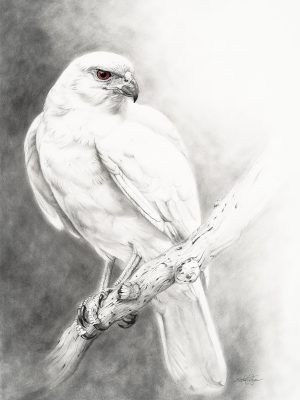
Grey goshawk - white morph (Accipiter novaehollandiae)
The grey morph has a pale grey head and back, dark wingtips, barred grey breast and tail, and white underparts. The white morph is the only bird of prey in the world to be entirely white.
Grey Goshawks are about 40–55 cm long, with wingspans of 70–110 cm. Females are much larger than males, weighing about 680 g. Males average 350 g.
Goshawks usually prey on mammals such as rabbits, possums, and bats. They may also eat birds, small reptiles, and insects. Females, due to their size, can catch larger prey than males.
Hunting is often done by stealth, and very successfully, but Grey Goshawks are willing to pursue their prey before catching it with their talons
Size: A2 (59.4 cm x 42 cm). Printed on 310 gsm Museum quality art paper.
This is an archival print.
*Price includes postage anywhere within Australia
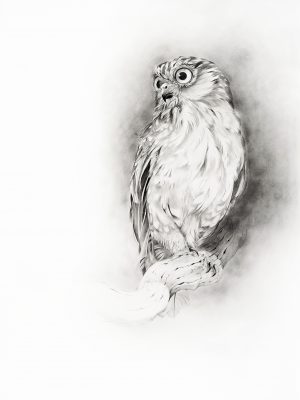
Southern Boobook owl (Ninox novaeseelandiae)
The Southern Boobook is the smallest and most common owl in Australia. It is identified by its plumage, which is dark chocolate-brown above and rufous-brown below, heavily streaked and spotted with white. The facial disc is chocolate brown and the eyes are large and yellowish. Tasmanian birds are smaller and more heavily spotted with white. Young Southern Boobooks are almost entirely buff-white below, with conspicuous dark brown facial discs. Like other owl species, the Southern Boobook is nocturnal.
Size: A2 (59.4 cm x 42 cm). Printed on 310 gsm Museum quality art paper.
This is an archival print.
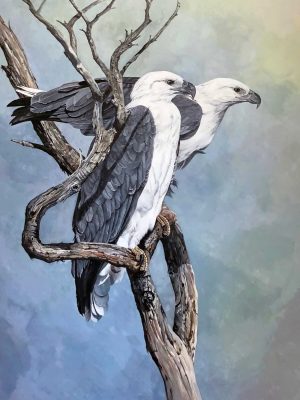
Print Size: 45cm x 30cm (no matt surround)
The white-bellied sea eagle (Haliaeetus leucogaster), also known as the white-breasted sea eagle, is a large diurnal bird of prey in the family Accipitridae. Originally described by Johann Friedrich Gmelin in 1788, it is closely related to Sanford's sea eagle of the Solomon Islands, and the two are considered a superspecies. A distinctive bird, the adult white-bellied sea eagle has a white head, breast, under-wing coverts and tail. The upper parts are grey and the black under-wing flight feathers contrast with the white coverts. The tail is short and wedge-shaped as in all Haliaeetus species. Like many raptors, the female is slightly larger than the male, and can measure up to 90 cm (35 in) long with a wingspan of up to 2.2 m (7.2 ft), and weigh 4.5 kg (9.9 lb).
This is an archival print. To view our limited edition prints click here.
*Price includes postage anywhere within Australia.
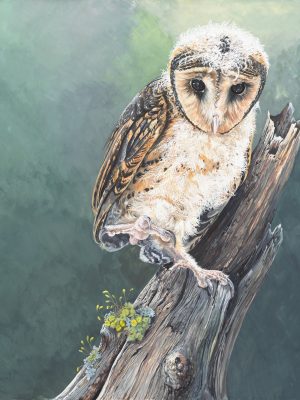
Immature Tasmanian Masked Owl (Tyto novaehollandiae castonops)
Montgomery (the owl) resides at the Raptor Refuge of Tasmania, Kettering. He enjoys educating school groups and takes his ambassadorial role very seriously.
(My sincere thanks to Luke O’Brien for his superb reference images)
This original piece is SOLD.
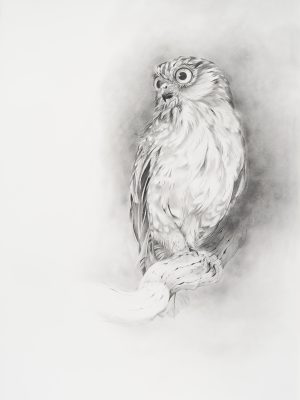
Southern Boobook owl (Ninox novaeseelandiae)
The Southern Boobook is the smallest and most common owl in Australia. It is identified by its plumage, which is dark chocolate-brown above and rufous-brown below, heavily streaked and spotted with white. The facial disc is chocolate brown and the eyes are large and yellowish. Tasmanian birds are smaller and more heavily spotted with white. Young Southern Boobooks are almost entirely buff-white below, with conspicuous dark brown facial discs. Like other owl species, the Southern Boobook is nocturnal.
This original piece is SOLD.
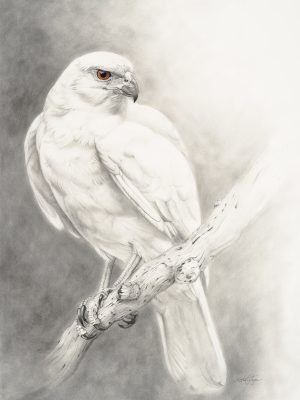
Grey goshawk - white morph (Accipiter novaehollandiae)
The grey morph has a pale grey head and back, dark wingtips, barred grey breast and tail, and white underparts. The white morph is the only bird of prey in the world to be entirely white.
Grey Goshawks are about 40–55 cm long, with wingspans of 70–110 cm. Females are much larger than males, weighing about 680 g. Males average 350 g.
Goshawks usually prey on mammals such as rabbits, possums, and bats. They may also eat birds, small reptiles, and insects. Females, due to their size, can catch larger prey than males.
Hunting is often done by stealth, and very successfully, but Grey Goshawks are willing to pursue their prey before catching it with their talons
This original piece is SOLD.
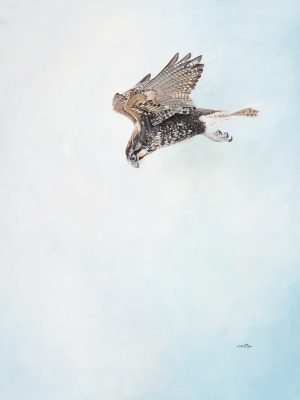
One of my favourite raptors. Usually around 40 cm to 50 cm long, they are found in light and dark forms and a variety of intermediates. They typically have red-brown heads with narrow black streaks with a light crown and off white chin. Wings are a spotted red-brown with dark brown quills. Beaks are light blue/grey, eyes are brown. The falcons make a loud cackle call uttered frequently. The brown falcon eats small mammals, including house mice and young rabbits. It also eats small birds, lizards, snakes and a variety of invertebrates particularly caterpillars, grasshoppers, crickets and beetles. Insects form the bulk of their diet during winter and the falcons often chase the insects on the ground!
(Sincere thanks once again to Clive Roper for his superb reference images)
This original piece is SOLD.

Tasmanian Wedge-tailed Eagle Nest (Aquila audax fleayi)
Wedge-tailed eagle nesting habitat is generally restricted to predominantly closed canopy old growth native forest, almost exclusively in tracts of tall eucalypt forest. Trees selected for nesting are among the largest in the locality, typically greater than 27 metres in height, with few exceptions. Nest trees normally occur on leeward slopes sheltered from prevailing strong winds.
The nest is a large structure of dead sticks, usually reused for years, often reaching considerable size. Nests 1.8 m across, 3 m deep and weighing about 400 kg are known. Nests have a shallow cup on the top, lined with fresh twigs and leaves. Sticks are added by a bird while it stands in the nest. If these sticks are dropped outside the nest, no effort is made to retrieve them. (With special thanks to Geoff ‘Hutcho’ Hutchinson for his fabulous reference images)
Listed: Endangered.
This original piece is SOLD.
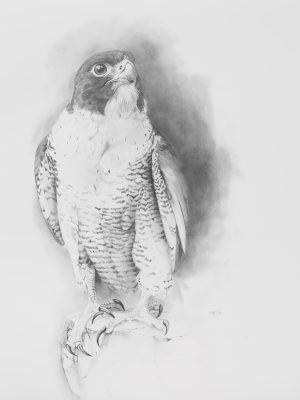
Peregrine falcon (Falco peregrinus)
All confirmed nests in Tasmania have been on cliffs. A site sheltered from heavy rain or high chill-factors is preferred and just a scrape is made to lay eggs.
Tasmania is a great place for peregrines but far from the best. The nesting population recovered from ravages of organochlorine pesticides in the 1960s, 1970s and into the 1980s, through legal protection in the early 1970s to now. With approximately 120 breeding pairs, the population has been relatively stable for some years now. Most are clustered in river valleys and along suitable coastline and on inshore islands and where close (< 4km apart) pairs tend to be evenly distributed due to their territorial nature. Nests are fiercely defended against all kinds of perceived threats and predators.
This original piece is SOLD.
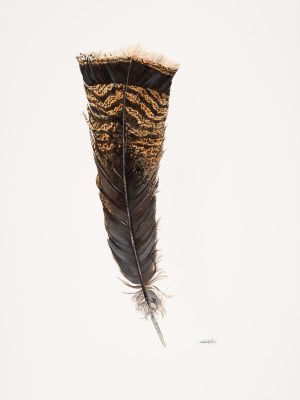
Feathers are epidermal growths that form a distinctive outer covering, or plumage on avian species. They are considered the most complex integumentary structures found in vertebrates and a premier example of a complex evolutionary novelty. As well as controlling flight and regulating temperature, they often attract more than just other birds with their beauty.
This original piece is FOR SALE. Please get in contact for more information.
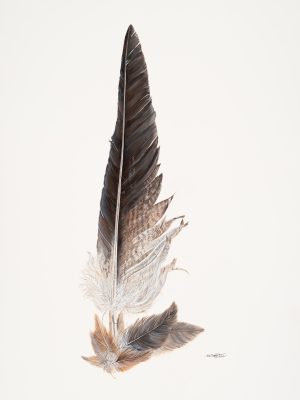
Tasmanian Wedge-tailed eagle (Aquila audax fleayi) feather.
The average wingspan for the Tasmanian Wedge-tailed eagle is typically is between 182 and 232 cm. The largest wingspan ever verified for an eagle was for this species. A female killed in Tasmania in 1931 had a wingspan of 284 cm, another female measured barely smaller at 279 cm.
This original piece is FOR SALE. Please get in contact for more information.

This female Peregrine was successfully rehabilitated at the Raptor Refuge of Tasmania, Kettering. A joy to watch and a very good news story.
The Peregrine Falcon is the embodiment of apex hunter; fastest animal in the world and master of the famous Peregrine ‘stoop’.
My portrait of Peregrine domesticity hopefully provides the viewer with a snapshot of another side to these magnificent raptors - that of protective maternal instinct and total commitment.
While the female incubates the eggs and the chicks newly hatched the family unit is fed on the nest by the male, hence her expression …’You’re Late’
(My sincere thanks to Luke O’Brien for his superb reference images)
Award of Excellence - Holmes Art Prize for Australian Bird Art, QLD 2021
This original piece is SOLD. To view available limited edition prints, please click here.
Please get in contact for more information.
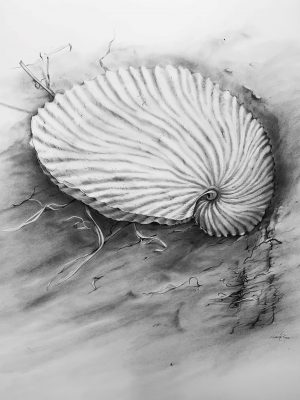
100 cm x 80 cm Framed. Graphite on 640 gsm hot press rag paper
The Argonaut, or paper nautilus, is actually a pelagic octopus. Females make a parchment-like shell (up to 30cm) which is used to carry incubating eggs and to trap surface air, which helps them maintain buoyancy.
This original piece is SOLD.
110 cm x 90 cm Graphite on 640 gsm hot press rag paper
The Aberdeen Angus, sometimes simply Angus, is a Scottish breed of small beef cattle. It derives from cattle native to the counties of Aberdeenshire and Angus in north-eastern Scotland. Angus cattle were first introduced to Tasmania (then known as Van Diemen's Land) in the 1820s and to the southern mainland in 1840. The breed is now found in all Australian states and territories, including King Island. With lush pastures and a temperate climate, the island is perfect for breeding the happiest, grass-fed cattle on the planet.
This original piece is SOLD. To view our limited edition prints click here.

Juvenile Tasmanian Wedge-tailed eagle, watercolour and gouache. 110 cms x 80 cms on 640 gsm hot press rag paper
The endangered Wedge-tailed Eagle subspecies Aquila audax fleayi occurs only in Tasmania. It is distinguished by its size (being Australia's largest bird of prey) and wedge-shaped tail. The total adult population has been estimated as less than 1000 birds. Principal threats include loss of nesting habitat, nest disturbance, collisions (with artificial structures, vehicles and aircraft), electrocution and persecution.
Aquila is a beloved member of The Raptor Refuge Inc. which is a not-for-profit organisation dedicated to caring and protecting Tasmania’s natural wildlife. https://www.raptorrefuge.com.au/
This original piece is SOLD.

Final Approach - White-bellied sea eagle
Watercolour gouache on 640gsm hot-press rag paper
Few Australian birds of prey are as spectacular as the White-bellied sea-eagle (Haliaeetus leucogaster). The White-bellied sea eagle is a large raptor that has long, broad wings and a short, wedge-shaped tail. It measures approximately 80 cm in length, and has a wingspan of 180–220 cm. Females weigh between 3-4.5 kg, and are larger than the males, which weigh between 2.5 and 3.7 kg.
This original piece is SOLD
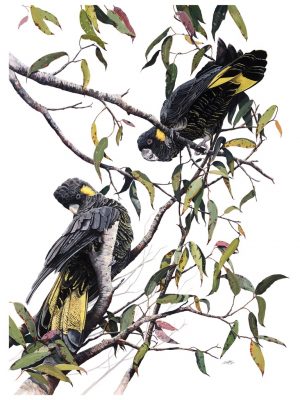
Watercolour gouache on 640gsm hot-press rag paper
The yellow-tailed black cockatoo (Calyptorhynchus funereus) is a large cockatoo native to the south-east of Australia measuring 55–65 cm (22–26 in) in length. Two subspecies are recognised, although Tasmanian and southern mainland populations of the southern subspecies xanthanotus may be distinct enough from each other to bring the total to three. It is a highly charismatic species with complex social behaviours making it well-loved amongst nature lovers.
This original piece is SOLD. To view it as a limited edition print, click here.

Limited edition print size 100 cm x 80 cm
The yellow-tailed black cockatoo (Calyptorhynchus funereus) is a large cockatoo native to the south-east of Australia measuring 55–65 cm (22–26 in) in length. Two subspecies are recognised, although Tasmanian and southern mainland populations of the southern subspecies xanthanotus may be distinct enough from each other to bring the total to three. It is a highly charismatic species with complex social behaviours making it well-loved amongst nature lovers.
*Price includes postage anywhere within Australia.

The Tasmanian masked owl (Tyto novaehollandiae castanops) is a bird in the barn owl family Tytonidae that is endemic to the island state of Tasmania, Australia. It is the largest subspecies of the Australian masked owl, the largest Tyto owl in the world, and is sometimes considered a full species. The sub-specific name castanops, meaning “chestnut-faced”, comes from the colouring of the facial disc.
This original print is SOLD. To view it as a limited edition print, click here.
